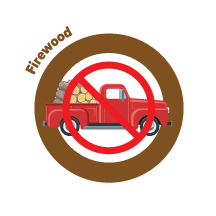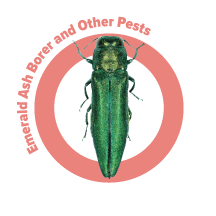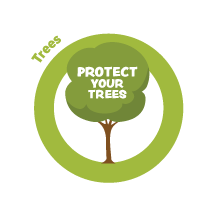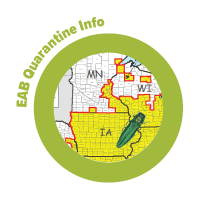Firewood
Moving firewood into North Dakota from out of state can introduce destructive pests.
The North Dakota Department of Agriculture, North Dakota Forest Service, and North Dakota Parks and Recreation strongly advise that firewood should be bought and used locally to prevent the spread of pests both within the state, and to prevent pests from accidentally entering the state.
North Dakota has more than 400,000 acres of community forests and almost 2 million acres of upland forests, riparian forests and rural tree plantings such as wind breaks. Protecting the health of these trees is a shared responsibility of everyone that values the natural environment of the Dakotas.
Moving uncertified firewood out of the areas under quarantine for these pests can be a federal offense. Nearby states with quarantines for these pests include Minnesota, Wisconsin, Iowa, Nebraska, Kansas, Oklahoma, Missouri, and Michigan.
Anyone who has moved firewood into the state from a regulated area is urged to burn it immediately. Do not bring it back with you, and please consult with your local Department of Agriculture prior to moving firewood across state or county boundaries next time. For more information on firewood pests, visit www.dontmovefirewood.org/.
Find and advertise local firewood here.
Destructive Pests
Many states in the Great Plains region near North Dakota have areas under quarantine for pests such as emerald ash borer (EAB), spongy moth, and Asian longhorned beetle, and it is illegal to move any regulated items (most firewood is considered a regulated item) from quarantined zones out of those states and into North Dakota without a state or federal inspection certificate, or a stamp certifying heat treatment. Other areas, such as Rocky Mountain states, could have regional pests of concern within their firewood - including mountain pine beetle, balsam woolly adelgid, walnut twig beetle and others. For more information on destructive pests, visit www.HungryPests.com.
Trees - Keeping North Dakota Forests Healthy
A great way to keep North Dakota forests healthy is to plant different varieties of trees. Tree diversity is critical for long-term survival. Be sure to purchase trees from inspected, pest-free, reputable sources and choose trees that are adapted to the environment to promote tree health. Check hardiness zones before you plant to ensure the tree is adapted for our state. For more information on the North Dakota nursery program or for a list of licensed nurseries, visit https://www.ndda.nd.gov/divisions/plant-industries/nursery-program.
Frequently Asked Questions
Why is it risky to move firewood?
• Firewood is typically cut from declining or dying trees that may be infested with a disease or insect pest. You can't see the pests and diseases since they are often tiny eggs or spores, and they may be under the bark. When firewood is moved, these pests can emerge or be spread from the firewood to healthy trees in the new area.
How can I reduce the risk of moving pests in firewood?
• Buy or gather local firewood. Local firewood, if infested with pests, reduces the likelihood of moving new pests to a new area.
Can I move firewood from another county? State?
• Moving firewood less than 50 miles from origin is generally acceptable. Firewood from certain areas of the country is prohibited movement into North Dakota to prevent the spread of emerald ash borer. See “what areas are quarantined” below for more information. Firewood movement outside a quarantined area, even in state, is prohibited.
Can I sell firewood from my property?
• Yes! Providing locally available firewood is a great way to prevent long-distance movement of pests. Do not sell across long distances unless firewood is treated or certified free of pests.
How can I be assured I am selling/buying pest-free firewood?
• Firewood that has been kiln-dried or heat treated, for example to 60˚C (140˚F) for a minimum 60 minutes, is typically approved effective for many pests, including emerald ash borer. Many states have adopted standards of 71.1˚C (160˚F) for a minimum 75 minutes for maximum pest control.
Has emerald ash borer (EAB) been found in North Dakota?
• YES. EAB was detected in LaMoure County, ND on August 20, 2024. NDDA places traps and visits suspect sites every year with help from city foresters, NDSU Extension and North Dakota Forest Service. NDDA maintains an EAB quarantine, details of which can be found here: https://www.legis.nd.gov/information/acdata/pdf/7-04-04.pdf.
What is a quarantine and what is regulated by it?
• A quarantine is a regulation of the movement of certain restricted products to prevent the spread of a pest. In the case of EAB, movement of the pest itself, hardwood firewood, nursery stock, untreated ash logs, limbs, branches, or roots of ash trees is restricted.
What areas are quarantined?
• Any state, county, or parish were EAB has been found. Firewood from these areas would be prohibited movement to North Dakota or within North Dakota without going through a treatment or inspected and found free from infestation by the state regulatory agency in the state of origin. Hardwood firewood is also required to be labeled as to harvested origin. A map of regulated areas can be found here.
Where can I find more information about firewood and invasive plant pests?
• There are several great resources online. Visit www.ndsu.edu/ndfs/health, www.dontmovefirewood.org or www.hungrypests.com for more information.
More Frequently Asked Questions
EAB Quarantine Info
Emerald Ash Borer Quarantined Areas (as of Nov. 24, 2025)
The entire states of:
Arkansas
Colorado
Connecticut
Delaware
Georgia
Illinois
Indiana
Iowa
Kansas
Kentucky
Maine
Maryland
Massachusetts
Michigan
Missouri
Nebraska
New Hampshire
New Jersey
New York
North Carolina
Ohio
Oklahoma
Pennsylvania
Rhode Island
South Carolina
Tennessee
Vermont
Virginia
West Virginia
Wisconsin
The partial states of:
North Dakota counties: LaMoure
Minnesota counties: Aitkin, Anoka, Benton, Blue Earth, Brown, Carlton, Carver, Cass, Chisago, Clay, Cottonwood, Crow Wing, Dakota, Dodge, Fairbault, Fillmore, Freeborn, Goodhue, Hennepin, Houston, Isanti, Itasca, Jackson, Kanabec, Kandiyohi, Lake, Le Sueur, Lyon, Martin, McLeod, Meeker, Mille Lacs, Morrison, Mower, Murray, Nicollet, Nobles, Olmsted, Ottertail, Pine, Pope, Ramsey, Redwood, Renville, Rice, Rock, Scott, Sherburne, Sibley, St. Louis, Stearns, Steele, Wabasha, Wadena, Waseca, Washington, Watonwan, Winona, Wright
Oregon counties: Clackamas, Marion, Multnomah, Washington, Yamhill
South Dakota counties: Brookings, Codington, Grant, Lincoln, Minnehaha, Turner, Union
Texas counties: Bell, Bowie, Bosque, Camp, Cass, Collin, Cooke, Dallas, Denton, Ellis, Franklin, Grayson, Harrison, Hill, Hood, Hopkins, Jack, Johnson, Lamar, Marion, McLennan, Morris, Navarro, Palo Pinto, Parker, Red River, Rockwall, Rusk, Somervell, Tarrant, Titus, Wise
Alabama counties: Calhoun, Cherokee, Cleburne, Jackson, Madison, St. Clair, Talladega
Louisiana parishes: Bossier, Bienville, Morehouse, Union, Ouachita, Lincoln, Claiborne, Webster, Jackson, Caddo, Richland, De Soto, La Salle, Winn, Natchitoches, Grant, Sabine, Red River, Caldwell, East Carroll, West Carroll, Catahoula
Related Resources
Plant Industries Contact
Charles Elhard
Plant Protection Officer
(701) 220-0485
celhard@nd.gov







